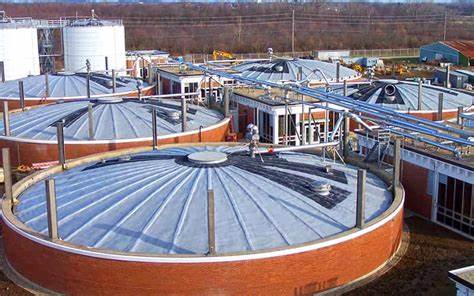
Introduction
Anaerobic digestion for wastewater treatment is a process that utilizes microorganisms to break down organic matter in the absence of oxygen. This natural process not only effectively treats wastewater but also produces renewable energy in the form of biogas. Wastewater treatment is of utmost importance for public health and environmental preservation.
Historical Background
Anaerobic digestion has been used since ancient times to treat organic waste. Over time, it has evolved to meet the needs of modern society, particularly in wastewater treatment. Today, anaerobic digestion is considered a sustainable and efficient method for managing wastewater, offering numerous advantages over traditional treatment methods.
Key Concepts and Definitions
Anaerobic digestion involves a series of biological reactions that occur without oxygen. It starts with hydrolysis, where complex organic compounds are broken down into simpler substances. This is followed by acidogenesis, acetogenesis, and methanogenesis, which leads to the production of methane-rich biogas. Wastewater treatment refers to the removal of contaminants from wastewater to ensure its safe discharge or reuse. Biogas, a byproduct of anaerobic digestion, contains methane and can be used as a renewable energy source. Digestion reactors play a vital role in the process, with different types designed for the various stages of anaerobic digestion.
Main Discussion Points
Benefits of Anaerobic Digestion for Wastewater Treatment
Anaerobic digestion offers several benefits for wastewater treatment. Firstly, it reduces organic pollutants in wastewater, resulting in cleaner effluent that can be safely released into the environment. Additionally, the process generates biogas, which can be utilized for electricity generation or heating purposes. Lastly, anaerobic digestion enables the recovery of valuable nutrients like phosphorus and nitrogen, which can be used as fertilizers, reducing the reliance on chemical fertilizers.
Anaerobic Digestion Process and Its Stages
The anaerobic digestion process consists of four stages: hydrolysis, acidogenesis, acetogenesis, and methanogenesis. Hydrolysis breaks down complex organic compounds into smaller molecules through the action of hydrolytic bacteria. Acidogenesis follows, where acidogenic bacteria convert these molecules into volatile fatty acids. Acetogenic bacteria produce acetate and hydrogen during the acetogenesis stage. Finally, methanogenic bacteria convert acetate and hydrogen into methane during the methanogenesis stage.
Factors Influencing Anaerobic Digestion Efficiency
Several factors influence the efficiency of anaerobic digestion. Temperature and pH are crucial in creating optimal conditions for the growth and activity of microorganisms. Mesophilic conditions around 35-40°C are typically preferred for efficient anaerobic digestion in wastewater treatment. Another important factor is the organic loading rate, which refers to the amount of organic matter added to the digestion system. Maintaining the right balance is crucial to prevent overloading the system. Reactor design and configuration also impact the efficiency of anaerobic digestion, with factors like mixing and retention time playing a significant role.
Case Studies or Examples
Successful Implementation of Anaerobic Digestion in a Wastewater Treatment Plant
A wastewater treatment plant in [Location] has successfully implemented anaerobic digestion for wastewater treatment. The plant has achieved impressive results in reducing organic pollutants, generating energy, and recovering nutrients. This case study emphasizes the importance of proper system design, operation, and maintenance for successful anaerobic digestion implementation.
Anaerobic Digestion for Small-Scale Wastewater Treatment in a Rural Community
In a rural community, anaerobic digestion has been used for small-scale wastewater treatment. This case study highlights the challenges faced by rural communities in wastewater management and the solutions provided by anaerobic digestion. The benefits include improved water quality, reduced odor, and renewable energy production.
Current Trends or Developments
Recent advancements in anaerobic digestion technology aim to improve process efficiency and biogas production. Researchers have explored strategies like pretreatments to enhance the degradation of complex organic compounds. Integration of anaerobic digestion with other wastewater treatment technologies, such as aerobic treatment, has also shown promising results in overall treatment efficiency.
Challenges or Controversies
The use of anaerobic digestion for large-scale wastewater treatment has faced some controversies. Critics argue that the process may not be suitable for treating certain types of industrial wastewater due to toxic compounds or high contaminant levels. The management of digestate, the residual material after anaerobic digestion, poses challenges in terms of disposal and potential environmental impacts.
Future Outlook
The potential applications of anaerobic digestion in wastewater treatment are extensive. Ongoing research and development are expected to further expand the process, particularly in areas with inadequate wastewater treatment infrastructure. The integration of anaerobic digestion with circular economy principles holds promise in achieving sustainability goals by minimizing waste and maximizing resource recovery. Emerging technologies like microbial electrochemical systems offer exciting possibilities for improving process efficiency and biogas production.
Conclusion
In conclusion, anaerobic digestion is a critical process in wastewater treatment, offering numerous benefits. It reduces organic pollutants, produces renewable energy in the form of biogas, and enables nutrient recovery. Understanding the key concepts and stages of anaerobic digestion is essential for optimizing its efficiency. Despite challenges and controversies, the future outlook for anaerobic digestion in wastewater treatment is promising, with potential applications in various sectors and integration with circular economy principles.